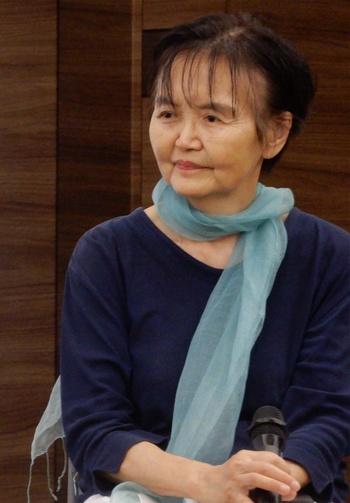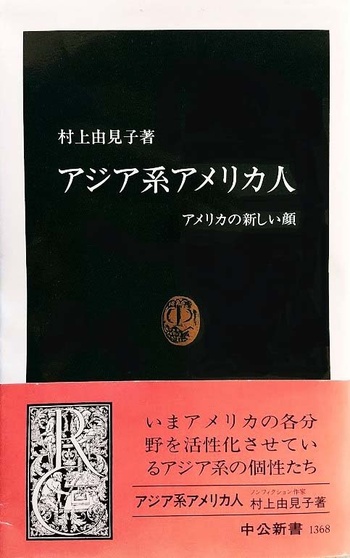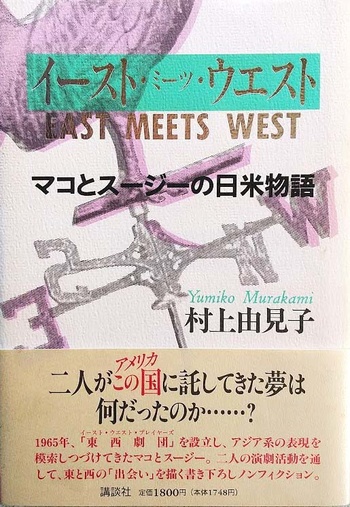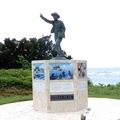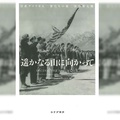Murakami Yumiko, a writer and researcher of ethnic culture, has been reporting on Japanese Americans and Asian Americans since the 1970s and publishing the results of her research in non-fiction and other books. We spoke to her about the track record and significance of her many years of reporting and research on the theme of Asian America.
Meeting with picture book author Taro Yashima
Kawai : Could you tell us about the historical flow of the research and interviews you have been involved in regarding Asian Americans and Japanese Americans?
Murakami: After graduating from university, I worked as an editor at a publishing company, where I was in charge of a picture book research magazine called "Monthly Picture Book." In the 1970s, picture books were finally starting to attract attention as a medium. It was around that time that I learned of a famous American picture book author named Yashima Taro. From what I've heard, he had defected to America before the war, and in the 1950s after the war, he published many picture books in America, won numerous awards, and established his position in the picture book world.
In 1976, while visiting my sister who was studying abroad in the US, I stopped off in Los Angeles and had the opportunity to meet Yashima Taro. The following year, when I returned to the US, I conducted a full interview with him and was overwhelmed by his dramatic life spanning both Japan and the US. The transcript of that interview was published in the September 1977 issue of Monthly Picture Books as "Yashima Taro of Los Angeles." In 1981, Usami Tsutomu's book "Goodbye Japan: Picture Book Author Yashima Taro and Mitsuko's Exile" (Shobunsha) won the Oya Soichi Non-Fiction Award and became a hot topic at the time.
Although Yashima is not what we would call a "Japanese person," he was surprised to learn that such people existed in America, and this was his first interest in the existence of Japanese and Japanese people overseas.
Around that time, more attention was being paid to Japanese Americans in Japan, and many books were published about them. Some of the books I enjoyed reading at the time were the reprints of prewar writer Tani Joji's accounts of his experiences in America, Merikenjappu Shobai Orai and Odoru Chiheisen (1975, Gendai Kyoyo Bunko), and Meiji Chichi America (1978, Shincho Bunko), a book about the life of Hoshi Shinichi's father, Hoshi Hajime. I was also engrossed in the short story collection California Yokohama Town (1978, Mainichi Shimbunsha) by second-generation Japanese-American Toshio Mori.
In the area of non-fiction related to Japanese Americans, photographers also published works one after another, such as Otani Isao's "Other People's Country, My Own Country: Records of Three Generations of the Japanese American Ozaki Family" (1980, Kadokawa Shoten) and Enari Tsuneo's "The Bride's America" (1980, Asahi Camera Special Edition). This was around the time that I myself began to research and learn about the history of Japanese Americans.
In your mid-twenties, everyone feels lost in their lives, ungrounded, and searching for something to anchor themselves to. I was no different. However, when I encountered the topic of Japanese Americans, I was drawn to it, as if I was searching for clues to my own life. However, because I am not an academic researcher, I approached the topic from a different perspective than an academic from the start.
Collecting the voices of the first generation
Kawai: As someone with a unique approach that sets you apart from scholars, what specific actions have you taken to delve deeper into this topic?
Murakami: My encounter with Yashima sparked my interest in Japanese and Japanese-Americans in America, and in 1980 I traveled to Los Angeles on my own. I obtained a journalist visa (I visa) through a Japanese publishing company, which allowed me to stay long-term. I decided to spend the first year as a "free-range" period, moving around freely. I was feeling my way around as to what I could do, but I decided to just meet real people and listen to their voices. My basic perspective was that of a freelance writer/journalist, and I had no intention of pursuing academia or research.
I started by listening to the stories of the first generation of Japanese Americans living in Los Angeles. Their stories, which were like living examples of the Meiji era Japanese, were fascinating, and I diligently wrote them down in my notebook. At the time, the first generation of Japanese Americans were already in their 80s and 90s, but looking back, I think this was the last time I was able to hear their precious stories.
Also, the UCLA library has a huge collection of reels of interviews with first-generation Japanese Americans from the Japanese American Research Project (JARP) in the 1970s, and I often went to listen to those as well. I wonder if they have been digitized by now.
Most of the Issei could not speak English, but their everyday conversations mixed English words they had learned by ear with their local dialects, and I was fascinated by the unique linguistic space that they created. Their unique spoken language, a mixture of broken English and Hiroshima and Kumamoto dialects, seemed to float in the air and was elusive, and I felt the difficulty and futility of putting it into print.
Later, I learned that first generation immigrants from any country in Europe or Asia survived by using a unique language that combined poor English with the local dialect. I hear that there are now studies on the language of those early immigrants at universities.
While listening to her story, I met Ms. Shinako Okamura, who was 99 years old at the time and had been taught by Umeko Tsuda at the Keiro Nursing Home, a nursing home for Japanese people that I visited as a volunteer. Ms. Okamura, a fifth-year student at Tsuda University (Women's English School), was fluent in English, full of humor, and had an excellent memory. I began the interview with the feeling that I had to get her story while I still could. The notes of the interview were handed over to Tsuda University and compiled into a booklet of oral histories for graduates.
After Shinako passed away at the age of 102, I felt the urge to document the turbulent history of this family that lived through the history of Japan and the United States. After six years of research, I wrote "One Hundred Years of Dreams: The Okamoto Family's America" (1989, Shinchosha).
I think it would be good to study more the history of Japanese people who moved to eastern New York and those involved in business. Around the same time, Haru Matsukata Reischauer's Silk and Samurai (1987, Bungeishunju) was published, which also provided a detailed introduction to the life of Arai Ryoichiro, who ran a successful silk business in New York in the early Meiji period.
Amid the turbulent history between Japan and the United States
Kawai: As you conducted these interviews, what attracted you the most?
Murakami: I think my interest in Japanese Americans initially came from the history between Japan and the U.S., which is connected to my own history. We tend to think of modern Japanese history and modern American history as separate, but with the start of immigration from the Meiji period, a close relationship was born between Japan and the U.S., where people and goods flowed between the two countries, different cultures collided, influencing politics and the economy, and even causing war.
In 1980, the issue of compensation for the wartime internment of Japanese Americans was brought to the forefront by third-generation Japanese Americans of my generation. The reason that third-generation Japanese Americans, born after the war and with no experience of internment, woke up to this issue was the spirit inherited from the era of minority protest in the 1960s.
Sansei in particular seemed to feel anger at the dark history of the internment measures that violated the U.S. Constitution, and also bitter and sad that their Nisei parents never told them anything about the internment camps. Some Sansei were also hurt because even their teachers at school did not believe them, saying that something like that could never have happened in America.
Young Sansei were demonstrating, holding up signs that read, "Justice Now! Compensation Now!" As I spoke to Issei, Nisei, and Sansei about this issue, I was deeply interested in the huge difference in perception between the different generations.
Many of the Issei look back on the past with a sense of resignation, saying, "Well, it couldn't be helped," while the Nisei spent their youth in a dark and sad state, torn apart over whether to choose Japan or the United States, and some even leaving internment camps to go to battlefields. Most of them say, "I don't want to talk about it now, and we don't want compensation." On the other hand, the Sansei cannot accept that 120,000 Japanese Americans were detained quietly like sheep, and are angry, saying, "As Americans, we should win compensation." I found each of their points of view convincing. This is precisely the difference in the generational perspectives of immigrant society.
Regarding the issue of compensation, compensation was realized under the Reagan administration, and payments of $20,000 each began to be made to the internees in 1990. The Japanese American Museum Los Angeles was established in 1992, and I have heard that quite a few second-generation Japanese donated the compensation money to the museum.
|
Murakami Yumiko: Born in Tokyo in 1951. Writer (representation culture, ethnic studies). Formerly a visiting professor at the University of Tokyo Graduate School and a part-time lecturer at Keio University. Her books include Yellow Face: Portraits of Asians in Hollywood Films (Asahi Sensho), A Hundred Year Dream: The Okamoto Family's America (Shinchosha, nominated for the Oya Soichi Non-Fiction Award), East Meets West: Mako and Suzie's Japan-America Story (Kodansha), Asian Americans: The New Faces of America (Chuko Shinsho), and 100 Years of Hollywood's Arabs: From Magic Lamps to Terrorists (Asahi Sensho). His translations include "Manhattan, September 11th: Survivor's Testimony" (Chuokoron-Shinsha), "The Shock Doctrine: Exposing the True Nature of Disaster-Based Capitalism" (co-translated, Iwanami Shoten), and "Yokohama Yankee: 150 Years of the Helmut Family Who Lived Between Japan, Germany, and America" (Akashi Shoten). |
© 2024 Ryusuke Kawai


